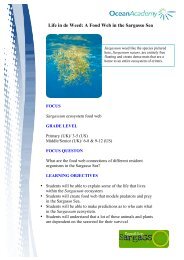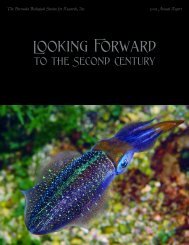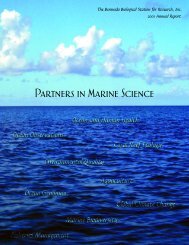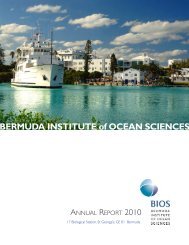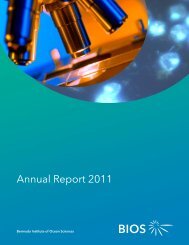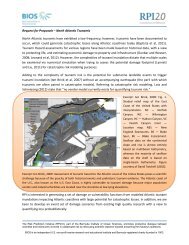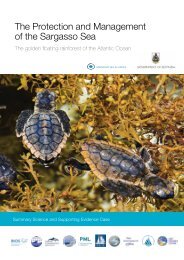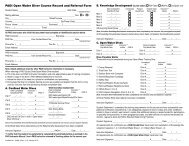BBSR 2002 Annual Report - Bermuda Institute of Ocean Sciences
BBSR 2002 Annual Report - Bermuda Institute of Ocean Sciences
BBSR 2002 Annual Report - Bermuda Institute of Ocean Sciences
Create successful ePaper yourself
Turn your PDF publications into a flip-book with our unique Google optimized e-Paper software.
The resulting libraries <strong>of</strong> bacterial clones are then screened t<strong>of</strong>ind the individual clones containing the genes that code forthe construction <strong>of</strong> the desired bioactive molecules, whichmay have important pharmaceutical or other applications.The molecular biology program has established closesynergistic relationships with other <strong>BBSR</strong> programs as well.The <strong>Ocean</strong>ic Microbial Observatory, developed at <strong>BBSR</strong> byDrs. Stephen Giovannoni <strong>of</strong> Oregon State University andCraig Carlson, now at the University <strong>of</strong> California, SantaBarbara, applies the tools <strong>of</strong> molecular biology to the study <strong>of</strong>microbial populations in the Sargasso Sea. The microbialobservatory has taken advantage <strong>of</strong>, and contributed to, themolecular biology instrumentation infrastructure at <strong>BBSR</strong>.For example, in 1997 <strong>BBSR</strong> acquired a state-<strong>of</strong>-the-art videomicroscope, which allows technicians to catalogue in secondsbacteria or other marine organisms that used to take weeks ormonths to study.Similarly, I am working closely with <strong>BBSR</strong>’s marine ecotoxicologyprogram, run by Dr. Richard Owen, to use the tools <strong>of</strong>genomics, proteomics and metabolomicsto develop diagnostic testsdesigned to monitor the health <strong>of</strong> keycomponents <strong>of</strong> coral reef ecosystems.The molecular biology programwas a key factor in the establishment<strong>of</strong> <strong>BBSR</strong>’s International Center for<strong>Ocean</strong> and Human Health in 1998.This research center is considered tobe one <strong>of</strong> the first to address oceanhealth/human health connections onan international scale.In addition, <strong>BBSR</strong>’s new molecularbiology capabilities have brought anew educational dimension to theinstitution over the past decade. Twosummer courses were developed that took advantage <strong>of</strong> thesecapabilities: Molecular Ecology and Physiology <strong>of</strong> MarineSymbioses, and Chemosensory Neurobiology in the MarineEnvironment. These continue to be popular <strong>of</strong>ferings in<strong>BBSR</strong>’s summer sessions. The opportunities to apply the techniques<strong>of</strong> molecular biology to questions concerning themarine environment drew an increasing number <strong>of</strong> applicantsto the annual NSF-funded Research Experience forUndergraduates semester at <strong>BBSR</strong>. A considerable number <strong>of</strong>these alumni have gone on to their graduate and pr<strong>of</strong>essionalcareers with a molecular approach to marine biology thatbegan at <strong>BBSR</strong>.Seminar courses on the application <strong>of</strong> molecular tools tomarine questions were also added to the curricula <strong>of</strong> <strong>BBSR</strong>’sDuke University and University <strong>of</strong> Rhode Island-RogerWilliams undergraduate spring and fall semester programs.The new Marine Genome Bankdata set may become as significantover time to the world <strong>of</strong> scienceas <strong>BBSR</strong>’s Hydrostation “S”time-series measurements,begun in 1954.At the graduate level, a long line <strong>of</strong> talented and motivatedstudents have conducted master’s and doctoral research in<strong>BBSR</strong>’s molecular biology laboratories. These students haveapplied molecular techniques to a number <strong>of</strong> topics, rangingfrom mangrove ecosystems to molecular taxonomy to themolecular physiology <strong>of</strong> symbiotic relationships that are thefoundation <strong>of</strong> <strong>Bermuda</strong>’s coral reef ecosystems. Their worknow comprises a significant contribution to pr<strong>of</strong>essionalmarine biology literature, and the students themselves havegone on to research, teaching and policy-making careers.From both a research and an educational perspective,<strong>2002</strong> was clearly the most fruitful year to date for <strong>BBSR</strong>’smolecular biology program. The skills and resources <strong>of</strong> theprogram were combined with those <strong>of</strong> the <strong>Ocean</strong>ic MicrobialObservatory to develop <strong>BBSR</strong>’s Marine Genome Bank.Libraries <strong>of</strong> environmental DNA, taken from blue-water environmentssuch as the Sargasso Sea and inshore environmentssuch as Harrington Sound and various coral reef settings, arebeing built and stored at <strong>BBSR</strong>. This bank <strong>of</strong> environmentalgenomic material will be available forthe research endeavors <strong>of</strong> bothresident and visiting, and academicand industrial, scientists seeking abetter understanding <strong>of</strong> how biologyworks in marine ecosystems and howthis biology can be harnessed for thebenefit <strong>of</strong> society.Arguably, this new data set,begun in <strong>2002</strong> from <strong>Bermuda</strong>’s idealmid-ocean location, may become assignificant over time to the world <strong>of</strong>science as <strong>BBSR</strong>’s Hydrostation “S”time-series measurements, begun in1954.Another exciting development at<strong>BBSR</strong> during <strong>2002</strong> was the addition <strong>of</strong> genomics pioneer Dr.Craig Venter to the Board <strong>of</strong> Trustees. His standing-room-onlypublic lecture in <strong>BBSR</strong>’s Hanson Hall in May <strong>2002</strong> broughtincreased attention to the unique opportunities that<strong>Bermuda</strong>’s location and <strong>BBSR</strong>’s genomics program provide tothe world <strong>of</strong> science. By year-end, <strong>BBSR</strong> had begun a researchcollaboration with Venter, Nobel Laureate Hamilton Smithand their colleagues, which we believe will bear fruit in yearsto come.In the short period <strong>of</strong> time that it has been in existence,the molecular biology program at <strong>BBSR</strong> has participated inone <strong>of</strong> the most pr<strong>of</strong>ound technological revolutions inmodern science. It’s safe to say that the vision <strong>of</strong> that 1987planning workshop has more than been fulfilled. At the sametime, the opportunities presented by the current period <strong>of</strong>rapid technological and scientific advances are even greater.Left: A diver collects samples from <strong>Bermuda</strong>’s coral reefs during the 1960sUpper right: Now only small amounts <strong>of</strong> material from marine sponges are needed for DNA cloning in the molecular biology laboratoryLower right: Associate Research Scientist Dr. Hank Trapido-Rosenthal loads <strong>BBSR</strong>’s new ABI 310 robotic DNA sequencer11



